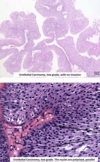17 - Renal Neoplasms Flashcards
What is the most common pediatric cystic renal disease and the most common cause of neonatal abdominal masses? How does it present?
Multicystic dysplastic kidney.
Presents as flank mass or pyelonephritis. If bilateral, neonates may have oligohydramnios and pulmonary hypoplasia. 10% also have urinary tract malformation.
Multiple cysts of various sizes, looks like bubble wrap.
What is the most common congenital kidney anomoly?
Horshoe kidney
90% fused at lower pole; most asymptomatic. Associated with obstruction, anomalous superior vena cava.
What causes polycystic kidney disease in adults?
Aut dominant - cortical based cysts caused by PKD1 or PKD2 mutation. Genes normally involved in epithelial calcium transport.
What causes polycystic kidney disease in children?
Aut recessive mutatoin in PKHD1 gene for fibrocystin.
Cysts are fairly small but uniformly distributed throughout cortex and medulla (whereas the adult form is in the cortex)
Affected babies have a high death rate and congenital hepatic fibrosis (serious liver condition) may co-exist.
What is acquired cystic disease?
Occurs in CKD pts on dialysis (60% of people on long-standing dialysis for 2-4 years get it)
Kidney is close to the normal size (As opposed to adult polycystic kidney disease where it’s much larger)
Genetically normal; prone to developing cancer
What does an oncocytoma arise from? How common are they?What is seen on histology?
Most common benign epithelial cell mass; arises from intercalated cells of he collecting duct.
Abundant pink cytoplasm from mito, round and regular nuclei. Minimal atypia.

What is an angiomyolipoma? What is the most serious complication?
A mesenchymal tumor made of vessels, smooth muscle, and fat.
The most ocmmon benign tumor of the kidney, and the most serious complication is hemorrhage.
Can see premelanosomes on EM.

What is Wilms tumor and what is the prognosis?
Almost always pediatric (ages 3-4); rarely seen in adults.
Contains a variety of cell and tissue components, all derived from immature kidney cells (mesoderm) - blastema
90% have a favorable histology and are easily cured.
What are the clinical symptoms associated with renal cell carcinoma?
Painless hematuria, a palpable abdominal mass, and dull flank pain.
Most frequent is hematuria (gross or microscopic) occuring in more than 50% of cases.
Polycythemia in 5-10% due to erythropoietin production by the tumor (paraneoplastic syndrome)
Order these renal tumors frmo worst outcome to best outcome: Angiomyolipoma, collecting duct (medullary carcinoma), renal oncocytoma, clear cell, papillary.
Worst: Collecting duct (medullaruy carcinoma) <1% of renal masses
Second worst: clear cell 83% of all renal cancers
Second best: Papillary 11% of all renal cancers, higher in younger and black population
Best: Chromophobe 4%
Oncocytoma: benign and rarely recurs
Angiomyolipoma: most frequent benign tumor of kidney, benign
What does clear cell carcinoma look like on histology and grossly?
Histology: clear abundant cytoplasm from glycogen
Grossly: areas of central softening from necrosis

What does papillary carcinoma look like on histology? What are the two types and which has a better outcome?
Finger-like papillae with foamy macrophages and prominent nucleioli. Stromal core.
Papillary type 1: have thin papillae covered with a single cuboidal cell layer with not much cytoplasm. Slightly better outcome than type 2.
Type 2: thick papillae and more cystoplasm.

What goes a chromophobe carcinoma look like grossly and histologically?
Well circumscribed with a central hemorrhage.
Halo around a wrinkled nucleus. Binucleate cells. May have areas of necrosis and calcification. May extend into perirenal fat.
Relatively indolent in nature.

What is the gross and histological appearance of collecting duct carcinoma?
Tumor is based in the medulla/collecting system. It extends towards the cortex to obscure the demarcation between the cortex and medulla.
Tumor forms glandular spaces, irregular aggregates of tumor cells form.

Who gets medullary carcinoma? How does it present? What is the prognosis?
Restricted to ppl with african or mediterranean descent.
Patients have sickle cell disease or trait.
Presents at a very high stage, resists chemo, and has worst outcome of all kidney cancers.
Medial survival time of 3 months.
What does medullary carcinoma look like on histology?
Cells with illdefined cytoplasmic borders and large vesicular nuelci.
Prominent nucleoli.
Growing in a glandular to solid shape.

What is acquired cystic disease-associated renal cancer? Who gets it?
Pts with acquired cystic disease due to chronic dialysis dependency have a 100x risk of gettinf renal cell carcinoma.
Variety of patterns but lots of vacuoles and oxalate crystals.

When does clear cell (tubulo)papillary cancer occur?
In end-stange kdineys whether non-cystic or cystic.
Indolent - some debate whether it’s cancer.

Describe the staing of renal cell carcinoma? What is the avg 5yr survival?
Depends if it’s confined to the kidney, outside of hte kidney, or invading the renal vein.
5yr survival is 50% but varies depending on subtype. If renal vein invasion or extension into perinephric fat, 5yr survival is reduced to 15% (but not for chromophobe - these ppl do better).

Describe renal cell carcinoma nucleolar grading in grades 1-4.


















